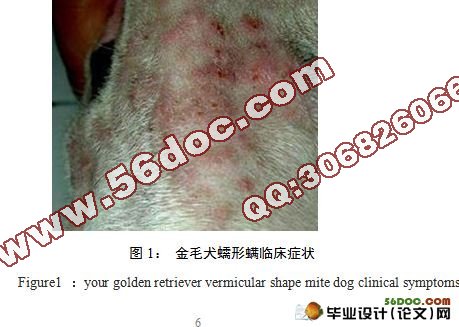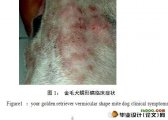犬蠕形螨病的防治(9700字)
摘 要:为了试验出犬蠕形螨效果优良的防治方案。从长沙各大宠物医院收集了近100例犬蠕形螨患犬,对这100例患犬主要通过刮片法、透明胶带法、挤刮法、皮肤活检等方法进行诊断。将通过诊断为阳性的病犬平均分成4组,对这4组进行不同的系统性的治疗。第一组的用药是伊维菌素、倍特液药浴、抗生素治疗。第2组的用药是阿维菌素、倍特液药浴、抗生素治疗。第3组是阿维菌素、倍特液药浴、、双甲脒、抗生素治疗。第4组是伊维菌素、倍特液药浴、抗生素、双甲脒、皮肤康治疗螨虫喷剂和外用药膏。通过5个星期的治疗,每组的治愈率分别是35%、25%、50%、75%,从这个结果看来,第4组对犬蠕形螨的治愈率是最高的,也就是说伊维菌素和皮肤康治疗螨虫喷剂和外用药膏对犬蠕形螨起到关键作用。
关键词:蠕形螨;诊断;抗生素
Prevention and treatment of demodicosis canine
Abstract: In order to test the effect of vermicular shape good dog prevention scheme of mite. From changsha each big pet hospital collected nearly 100 cases of vermicular shape with dog dog, the mite mainly through 100 cases of dog air-compressor method, scotch tape method, crowded shave method, the skin biopsies diagnosed such methods. The diagnosis of positive through ill dog, the average divided into four groups of these four groups for different systemic treatment. The first group of drug use is 2ml contains 0.02g ivermectin, times liquid, antibiotics, herb. The second group of drug use is abamectin, herb, times liquid, antibiotic treatment. The first three groups is abamectin, herb, times liquid, double armour processes, and antibiotic treatment. Group 4 is 2ml contains 0.02g ivermectin, times especially liquid medicine bath, antibiotics, double armour processes, skin kang treatment mite spray and topical creams. Through five weeks of treatment, and each group cure rate were 35%, 25%, 50%, 75%, from the result of group 4, it seems, the cure rate mite dog creep form is the tallest, i.e. 2ml contains 0.02g ivermectin and skin treatment mite spray and Cornwall topical creams mite of dog vermicular shape played a key role.
Keyword: demodex ;diagnose;antibioti

目录
摘要………………………………………………………………………………………1
关键词……………………………………………………………………………………1
1前言………………………………………………………………………………………2
1.1 病原特征…………………………………………………………………………2
1.2 流行病学…………………………………………………………………………2
1.3 致病机理…………………………………………………………………………3
2 材料………………………………………………………………………………………4
2.1 病例………………………………………………………………………………4
2.2 诊断材料和试剂…………………………………………………………………4
2.3 药品………………………………………………………………………………4
3 方法………………………………………………………………………………………4
3.1 诊断方法…………………………………………………………………………5
3.2治疗方案……………………………………………………………………………5
4结果与分析…………………………………………………………………………………8
5讨论与体会…………………………………………………………………………………8
参考文献 …………………………………………………………………………………10
致谢………………………………………………………………………………………11
|



